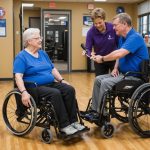Understanding the Relationship Between Virtual Learning and Physical Activity
In recent years, virtual learning has become increasingly prevalent, reshaping how teenagers engage with education across the globe. This digital shift raised questions about its connection to physical activity among teens. Research indicates that the virtual environment can impact physical activity levels, with both positive and negative outcomes.
Existing studies reveal a nuanced picture. On one hand, virtual learning offers flexible schedules, providing teenagers the potential to incorporate exercises into their daily routine. On the other hand, the lack of structured school-based physical education can lead to decreased physical activity. Studies show variations in outcomes depending on factors such as home environment and parental support.
Also read : Unlocking Heart Health: The Surprising Perks of Omega-3 Fatty Acids for Your Cardiovascular Well-being
Teenagers’ physical activity levels are influenced by their access to resources like outdoor spaces and virtual fitness programs. Peer interaction and motivation can also affect their willingness to engage in physical activity during virtual learning.
Thus, the impact of virtual learning on teenagers’ activity levels doesn’t hinge on the medium alone. Comprehensive strategies that promote balance between digital engagement and physical exercise are vital. Understanding these dynamics benefits educators, parents, and policymakers, as they work to support healthier lifestyles in virtual contexts.
Also to see : Evaluating the Impact of Enhanced Recovery After Surgery (ERAS) on Shortening Hospital Stays for Colorectal Surgery Patients
Positive Effects of Virtual Learning on Teenagers’ Physical Activity
While virtual learning has introduced challenges, it also presents several benefits, particularly by offering flexible schedules. This increased flexibility can encourage teenagers to incorporate physical activities like sports or regular exercise into their daily routine. With the traditional school day restructured, teens have the autonomy to design timetables that can harmonize academics with physical pursuits.
Several case studies highlight instances where online learning has led to increased involvement in sports or fitness activities. For instance, students participating in virtual courses reported finding more time to engage in midday runs or evening sports sessions. This shift has enabled them to integrate fitness into their revamped schedules seamlessly.
Experts suggest that virtual environments can inspire creative and personalised fitness routines. Teens have the opportunity to explore diverse workouts that fit their interests, utilising online resources and apps. Virtual learning platforms often include unique features like fitness challenges or interactive classes, fostering an engaging and motivating atmosphere.
Thus, the capability to tailor individual workouts and flexibility to participate at any time epitomizes the potential benefits inherent in virtual learning setups. Such advancements can significantly influence teenagers’ motivation to maintain regular physical activity.
Challenges of Physical Activity in Virtual Learning Settings
Virtual learning has introduced several barriers to physical activity among teenagers. One major concern is the increase in sedentary behaviour due to prolonged screen time. Sitting for extended periods can lead to reduced physical movement, impacting overall health.
The home environment significantly influences teenagers’ physical activity levels. The availability of space and resources for exercise, like room to move or access to outdoor areas, plays a crucial role. Additionally, parental influence is a key factor; parents who actively encourage and facilitate regular activity often see more active children.
Experts have voiced concerns regarding the psychological impact of the virtual learning framework. They suggest that motivation among teens to remain physically active might dwindle without in-person interactions common in traditional school settings. The lack of peer support and competition can lead to decreased enthusiasm for exercise.
Moreover, the blend of academic pressures and screen time can foster a cycle of inactivity. Experts recommend balancing screen time with physical activities to counteract these challenges. Creating a structured environment that encourages regular breaks for movement is critical in supporting teenagers’ health and well-being. Shifting the focus to intentional, short bursts of activity can mitigate some effects of sedentary behavior.
Strategies to Enhance Physical Activity During Virtual Learning
Promoting physical activity among teenagers in a virtual learning environment is crucial. Educators and parents can implement various strategies to encourage regular movement during online classes. A key approach is to integrate health tips into students’ daily routines. By scheduling breaks for exercise or stretching, they can reduce sedentary behaviour and increase energy levels.
Virtual fitness programs offer tailored options for teenagers, making fitness accessible and engaging. These programs often include interactive workouts that can be customized to individual preferences and abilities, providing a sense of ownership and motivation to stay active. Fitness apps with challenges or leaderboards can further drive engagement, encouraging teens to reach activity goals.
Furthermore, gamification and technology play pivotal roles in making exercise appealing. Platforms offering fitness games that combine entertainment with activity can capture teenagers’ interests, transforming exercise into a fun experience. By linking rewards and progress tracking, these platforms not only promote physical activities but also enhance motivation.
By applying these strategies, teenagers can maintain a balance between virtual learning and staying active. Encouraging these practices helps create a sustainable environment where academic pursuits and physical health coexist effectively.
Case Studies and Testimonials
Understanding the impact of virtual learning on teenagers’ physical activity can be enhanced through real-life examples. Several case studies highlight successful strategies for integrating physical activity within a virtual education framework. For instance, one school district implemented a virtual fitness program that encouraged students to log daily exercises, leading to a noticeable uptick in activity levels. Such programs often offer an innovative mix of challenges and rewards to keep participants engaged.
Testimonials from both students and parents provide a glimpse into their experiences and adjustments. Many teenagers reported newfound enjoyment in crafting personalised fitness routines, benefiting from the flexibility that virtual learning provides. Parents have observed increased levels of physical activity, primarily when online schedules allow families to partake in activities together, such as midday walks.
The long-term benefits of these changes are emerging as teens develop healthier routines. Regular involvement in physical activities not only boosts teenagers’ physical health but also positively influences their mental well-being. Experts suggest that continuous support and encouragement from both teachers and families can cement these activities into lifelong habits. Incorporating community-based initiatives may further enhance social bonds, providing additional motivation for maintaining an active lifestyle.
Recommendations from Experts
In the virtual learning landscape, experts provide vital insights into promoting physical activity levels among teenagers. They stress the importance of designing a balanced approach to screen time and physical movement. One primary recommendation involves integrating regular breaks for stretching or short exercises during academic tasks to counteract the effects of prolonged sitting.
Maintaining structure is another key suggestion. Experts advocate for establishing consistent daily routines that incorporate scheduled physical activities. This can help maintain a healthy balance between educational commitments and the need for exercise.
Looking ahead, experts anticipate future trends in virtual learning to include more interactive platforms designed to engage teens in physical fitness. Advanced technology, such as augmented reality (AR) and virtual reality (VR), is expected to transform exercise experiences, making them more immersive and engaging.
Moreover, experts recommend that educators and policymakers actively incorporate health recommendations into virtual curricula. Encouraging partnerships with community organisations can also promote social interaction and physical activities beyond the confines of home.
By following these expert insights, stakeholders can create a supportive environment that prioritises teens’ physical health alongside their academic achievement in virtual settings.











